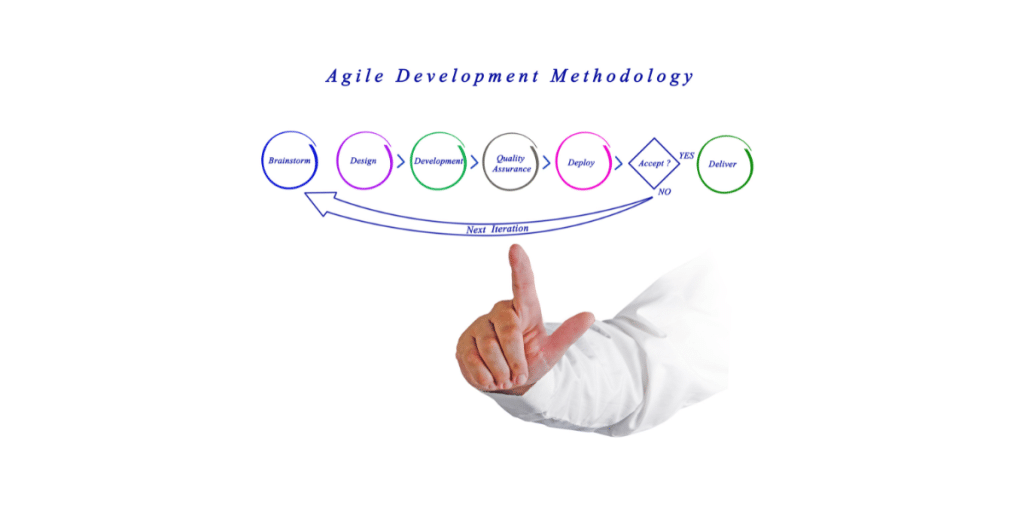The world of project management is ever-evolving, and the agile methodology has proven to be a game-changer. It’s a flexible, collaborative approach that’s helped countless teams improve their efficiency and deliver high-quality results. In this blog post, we’ll dive deep into the agile methodology, answering the question: “What is agile and how can it benefit my team?” We’ll also explore the principles and practices that set agile apart from traditional project management methods, and provide tips on how to implement it effectively in your organization. So, strap in and get ready to learn how agility can transform your team’s performance and productivity.
What is Agile Methodology?
Agile methodology is a set of principles and practices aimed at delivering products or services in an efficient and effective manner. It is a flexible approach to project management that emphasizes collaboration, adaptability, and iterative development.
Understanding Agile Methodology
Agile methodology is a response to the limitations of traditional project management approaches, which often rely on rigid planning, extensive documentation, and a sequential process. In contrast, agile methodology prioritizes customer satisfaction, working software, and responding to change.
At its core, agile methodology is about empowering teams to work together towards a common goal. It involves breaking down work into small, manageable chunks, or “sprints,” and focusing on delivering value to the customer at every stage of the development process.
Agile Manifesto
The Agile Manifesto is a set of guiding values and principles for agile methodology. It was created in 2001 by a group of software developers who were looking for a better way to manage their projects. The four values of the Agile Manifesto are:
- Individuals and interactions over processes and tools
- Working software over comprehensive documentation
- Customer collaboration over contract negotiation
- Responding to change over following a plan
These values are supported by 12 principles that guide the implementation of agile methodology. Some of these principles include:
- Deliver working software frequently, with a preference for shorter timescales
- Build projects around motivated individuals, and give them the support and resources they need to get the job done
- Emphasize face-to-face communication as the most effective way of conveying information within a team
- Respond to change quickly, even if it means changing course mid-project
Principles of Agile Methodology
Agile methodology is based on a set of core principles that guide the development process. These principles include:
- Customer satisfaction: The highest priority is to satisfy the customer through early and continuous delivery of valuable software.
- Iterative development: Projects are broken down into small, manageable chunks that are developed and tested in short cycles.
- Collaboration: Team members must work together closely to ensure that the project stays on track and meets the customer’s needs.
- Adaptability: The ability to respond to changing requirements and feedback is key to the success of an agile project.
By following these principles, agile teams are able to deliver high-quality, customer-focused products or services in a timely and efficient manner.

For more information on agile methodology and how it can be used in project management, check out the Agile Alliance website.Agile Alliance
Benefits of Agile Methodology
Agile methodology is a project management approach that emphasizes flexibility, collaboration, and iterative development. It is widely adopted by organizations nowadays due to its numerous benefits. In this article, we will discuss the advantages of Agile methodology in detail.
Increased Flexibility
One of the key benefits of Agile methodology is increased flexibility. Unlike traditional project management methods, Agile allows for changes to be made mid-project. This means that teams can adapt to new requirements or feedback from stakeholders more easily, without disrupting the project timeline. In addition, Agile provides a framework for continuous improvement, allowing teams to refine and optimize their processes over time.
Faster Time-to-Market
Another benefit of Agile methodology is faster time-to-market. Agile enables teams to deliver working software in short iterations, typically two to six weeks in length. This approach allows for rapid prototyping and testing, reducing the time and cost associated with traditional software development methods. Additionally, Agile promotes a culture of continuous delivery, ensuring that new features and updates are released to users quickly and frequently.
Improved Quality
Agile methodology also promotes improved quality in software development. By breaking down projects into smaller, more manageable pieces, teams can focus on delivering high-quality features that meet user needs. Agile also emphasizes collaboration between developers and stakeholders, ensuring that everyone is aligned on project goals and requirements. This approach helps to reduce the risk of errors or miscommunications, leading to better quality software.

Enhanced Customer Satisfaction
Finally, Agile methodology can lead to enhanced customer satisfaction. By involving stakeholders in the development process and delivering working software in short iterations, Agile ensures that the final product meets user needs and expectations. Additionally, Agile allows for feedback to be incorporated into the development process quickly, ensuring that the final product is tailored to user requirements. This approach helps to build trust between the development team and stakeholders, leading to increased satisfaction and engagement.
Overall, Agile methodology is a powerful approach to project management that offers numerous benefits. By prioritizing flexibility, speed, quality, and customer satisfaction, Agile enables teams to deliver high-quality software that meets user needs and drives business value.
Agile Methodology Frameworks
Agile methodology is an iterative approach to project management that prioritizes continual improvement and adaptation to changing circumstances. Four popular frameworks of agile methodology include Scrum, Kanban, Lean, and Extreme Programming (XP).
Scrum
Scrum is a framework that emphasizes teamwork, collaboration, and iterative progress. In Scrum, a cross-functional team works together to complete a project in short, iterative cycles called “sprints.” The team meets daily during the sprint in a brief standup meeting to discuss progress and any obstacles they are facing. At the end of each sprint, the team presents their work to stakeholders for feedback and adjusts their approach for the next sprint.

Scrum.org provides more information on what Scrum is and how to implement it in your organization.
Kanban
Kanban is a framework that emphasizes visualizing work and limiting work in progress to maximize efficiency. In Kanban, work is represented by cards or sticky notes on a board, which are moved through various stages of completion. The goal is to optimize the flow of work by identifying bottlenecks and constantly improving the process. Kanban is often used in manufacturing and software development environments.
Learn more about Kanban and how to implement it in your organization.
Lean
Lean is a framework that focuses on maximizing customer value while minimizing waste. Lean is based on the Toyota Production System and emphasizes continuous improvement and respect for people. Lean principles can be applied to any industry, not just manufacturing.

Find more information on what Lean is and how to apply it to your organization.
Extreme Programming (XP)
Extreme Programming (XP) is a framework that emphasizes high-quality software development through pair programming, test-driven development, and continuous integration. XP also emphasizes customer involvement and frequent releases. XP is often used in software development environments.
Find more information on what Extreme Programming is and how to implement it in your organization.
There are many other agile frameworks out there, but these four are some of the most popular and widely used. By adopting an agile approach to project management, organizations can improve efficiency, collaboration, and customer satisfaction.
Agile Methodology Best Practices
Agile methodology is a popular approach to software development that emphasizes flexibility, collaboration, and iterative development. To get the most out of this approach, there are several best practices that teams should follow.
Continuous Feedback Loop
One of the key principles of agile methodology is a continuous feedback loop. This means that teams should be constantly seeking feedback from stakeholders, customers, and other team members throughout the development process. This feedback can be used to make adjustments to the project as it progresses, ensuring that the final product meets the needs of all involved.

Learn more about continuous feedback loop.
Collaboration and Communication
Agile methodology also emphasizes collaboration and communication. Teams should be working closely together, sharing information and ideas throughout the development process. This helps to ensure that everyone is working toward the same goals, and that any issues or challenges are identified and addressed as quickly as possible.

Learn more about collaboration and communication in agile.
Iterative Development
Iterative development is another key principle of agile methodology. This means that rather than trying to create a perfect product from the start, teams should focus on creating a working prototype and then iteratively improving it through multiple rounds of feedback and testing. This approach allows teams to respond quickly to changes and ensures that the final product is as close to perfect as possible.
Learn more about iterative development.
Test-Driven Development (TDD)
Test-driven development (TDD) is a development approach in which tests are written before the code is written. This helps to ensure that the code meets the requirements and that any bugs are caught early in the development process. TDD is a great way to ensure that the final product is high-quality and meets the needs of all stakeholders.
Learn more about test-driven development.
By following these best practices, teams can get the most out of agile methodology and ensure that their final product is high-quality and meets the needs of all stakeholders.
Challenges of Agile Methodology
In today’s fast-paced world, businesses are seeking ways to increase their agility and adapt to changing markets. Agile methodology has emerged as a popular approach to software development that aims to improve flexibility, collaboration, and efficiency. However, while agile methodology has many benefits, it also comes with some challenges.
Resistance to Change
When adopting agile methodology, there is often resistance to change from team members who are used to traditional, sequential development processes. This can lead to skepticism, mistrust, and a lack of buy-in from key stakeholders. To overcome this challenge, it is important to educate team members on the benefits of agile methodology and to involve them in the process from the beginning.
Lack of Discipline
One of the core principles of agile methodology is organisation. This means that teams are responsible for managing their own work and making decisions collectively. However, without a strong sense of discipline, this can lead to chaos and disorganization. To mitigate this challenge, it is important to establish clear guidelines, roles, and responsibilities, and to hold team members accountable for their actions.
Over-emphasis on Process
Agile methodology places a strong emphasis on process and continuous improvement. While this can be beneficial, it can also lead to a focus on process at the expense of delivering value to customers. To avoid this challenge, it is important to strike a balance between process and outcomes, and to ensure that the team is always working towards delivering value.
Overall, while agile methodology has many benefits, it also comes with some challenges. By focusing on educating team members, establishing clear guidelines and roles, and balancing process and outcomes, businesses can overcome these challenges and reap the benefits of agile methodology.
Conclusion
In conclusion, agile methodology is a powerful project management approach that emphasizes flexibility, collaboration, and continuous improvement. By breaking down complex projects into smaller, more manageable pieces, agile teams can improve efficiency, reduce risk, and deliver high-quality results on time and within budget. By embracing agile practices, organizations can adapt to changing business needs, improve customer satisfaction, and foster a culture of innovation and creativity. With its focus on communication, iteration, and customer feedback, agile methodology provides a framework for success that can benefit businesses of all sizes and industries. So, if you want to stay competitive in today’s fast-paced marketplace, embrace agile methodology and see the results for yourself.
Related Links:












